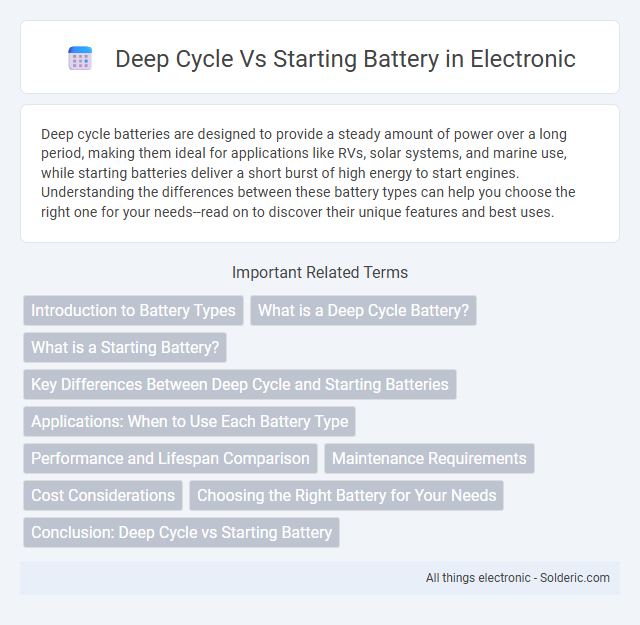Deep cycle batteries are designed to provide a steady amount of power over a long period, making them ideal for applications like RVs, solar systems, and marine use, while starting batteries deliver a short burst of high energy to start engines. Understanding the differences between these battery types can help you choose the right one for your needs--read on to discover their unique features and best uses.
Comparison Table
| Feature | Deep Cycle Battery | Starting Battery |
|---|---|---|
| Purpose | Designed for sustained power over long periods | Delivers short, high bursts of energy to start engines |
| Discharge Depth | Supports deep discharge, typically up to 80% | Can only handle shallow discharge, around 10-20% |
| Cycle Life | High cycle life, ideal for repeated charging and discharging | Lower cycle life, optimized for quick starts |
| Construction | Thicker plates for durability and deep discharge | Thinner plates for increased surface area and cranking power |
| Applications | Solar systems, golf carts, RVs, marine use | Cars, trucks, motorcycles, lawn mowers |
| Cost | Generally higher due to durability and capacity | Lower cost, focused on engine starting |
Introduction to Battery Types
Deep cycle batteries deliver sustained power over extended periods, making them ideal for applications such as solar energy storage, marine use, and RVs where consistent energy output is crucial. Starting batteries, also known as cranking batteries, provide short bursts of high current necessary to start engines in vehicles like cars and trucks. Understanding the fundamental differences in design and function between deep cycle and starting batteries helps optimize battery selection based on specific energy requirements and usage scenarios.
What is a Deep Cycle Battery?
A deep cycle battery is designed to provide a steady amount of power over an extended period, making it ideal for applications like solar energy systems, RVs, and marine use. Unlike starting batteries that deliver short bursts of high current to start engines, deep cycle batteries can be discharged up to 80% without damaging their lifespan. Your choice should consider the battery's ability to endure repeated deep discharges while maintaining reliable energy output.
What is a Starting Battery?
A starting battery, also known as a cranking battery, is designed to provide a high burst of current to start an engine quickly. It features thin plates that deliver a large amount of power in a short time but are not suited for deep discharge cycles. Unlike deep cycle batteries, starting batteries prioritize quick energy delivery over prolonged energy supply and frequent recharging.
Key Differences Between Deep Cycle and Starting Batteries
Deep cycle batteries are designed to provide a steady amount of power over a long period, making them ideal for applications like marine use, RVs, and solar energy systems. Starting batteries deliver a quick burst of high current to start engines and are optimized for short, powerful discharges. Understanding the key differences in capacity, discharge rate, and intended use helps you choose the right battery for your specific needs.
Applications: When to Use Each Battery Type
Deep cycle batteries are ideal for applications requiring slow, consistent power output such as RVs, solar energy systems, and marine trolling motors where prolonged energy delivery is essential. Starting batteries excel in automotive and motorcycle engines, providing high burst power needed to crank the engine quickly during ignition. Selecting the correct battery type enhances performance and longevity by matching the energy demands to the battery's design specifications.
Performance and Lifespan Comparison
Deep cycle batteries deliver steady power over long periods, making them ideal for applications requiring sustained energy, such as marine or solar systems, while starting batteries are designed to provide quick bursts of high current to start engines. In terms of lifespan, deep cycle batteries typically endure 500 to 1,000 charge-discharge cycles due to their robust construction and thicker plates, whereas starting batteries have fewer cycles, generally around 200 to 300, because they prioritize cranking power over deep discharge tolerance. Performance degradation in starting batteries occurs rapidly when used in deep cycle applications, while deep cycle batteries maintain better capacity and reliability under repeated deep discharging conditions.
Maintenance Requirements
Deep cycle batteries require regular maintenance such as checking electrolyte levels and ensuring terminals are clean to maximize lifespan and efficiency. Starting batteries typically need less frequent maintenance due to their sealed design but still benefit from periodic inspections to prevent corrosion and ensure reliable performance. Your choice should consider how much time you can dedicate to upkeep based on these maintenance demands.
Cost Considerations
Deep cycle batteries generally cost more upfront compared to starting batteries due to their specialized design for sustained energy delivery and durability. Starting batteries prioritize high cranking power but have a shorter lifespan and may require more frequent replacement, impacting long-term costs. Investing in a deep cycle battery often results in better value over time for applications involving continuous power usage, offsetting the higher initial price.
Choosing the Right Battery for Your Needs
Deep cycle batteries provide sustained power over extended periods, making them ideal for applications like RVs, solar energy storage, and marine use, where consistent energy discharge is essential. Starting batteries, on the other hand, deliver quick bursts of high current to start engines, suitable for cars, motorcycles, and boats with internal combustion engines. Evaluating your energy demand--whether short, intense power or prolonged, steady power--ensures you select the correct battery to maximize performance and lifespan.
Conclusion: Deep Cycle vs Starting Battery
Deep cycle batteries deliver sustained power over long periods, making them ideal for applications like RVs, solar energy storage, and marine use, where consistent energy output is crucial. Starting batteries provide short bursts of high current necessary for engine ignition and are designed to recover quickly after cranking. Choosing between deep cycle and starting batteries depends on whether the primary need is prolonged energy delivery or rapid starting power.
Deep cycle vs starting battery Infographic

 solderic.com
solderic.com